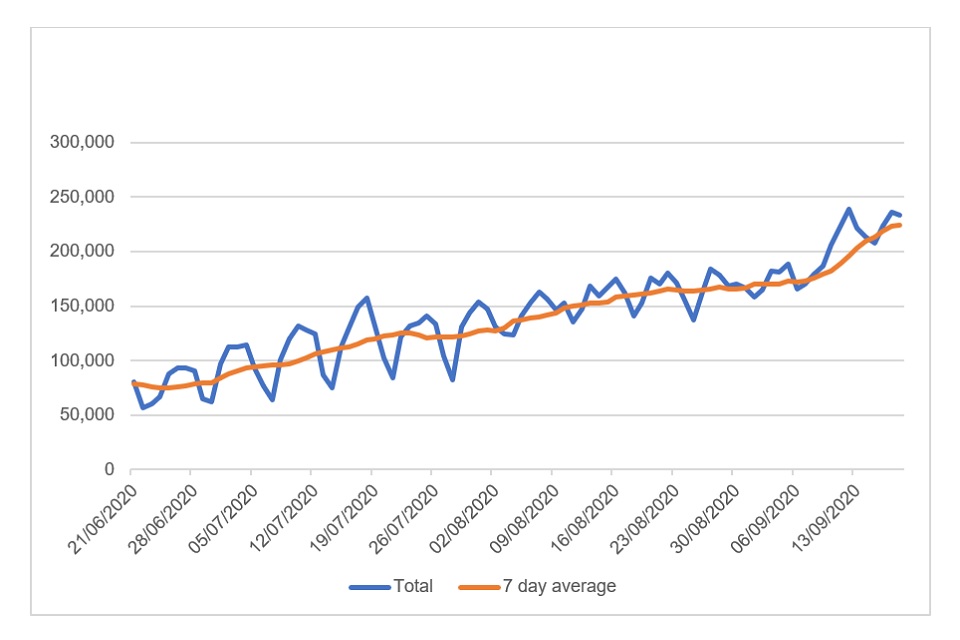Allocation of COVID-19 swab tests in England
Published 21 September 2020
Applies to England
Introduction
You should only get tested if you have COVID-19 symptoms or if you’ve been advised to get tested by a health professional. The symptoms are:
- a high temperature
- a new, continuous cough
- a loss or change to your sense of smell or taste
Unless a health professional has instructed you differently, you should not get tested if you do not have COVID-19 symptoms, even if a close contact or household member has tested positive.
The COVID-19 testing programme has been built at unprecedented pace and scale to support our management of the COVID-19 pandemic. We have processed on average 225,000 swab tests[footnote 1] a day across the UK over the past week, which are record levels.
We are further increasing our capacity as quickly as we can to 500,000 swab tests a day by the end of October. We currently test at higher levels per capita than countries of comparable size including Germany, France and Spain[footnote 2].
While capacity is at a record high, demand has rapidly increased and is currently above these levels.
As we look towards winter, we have set out below those who we intend to test, as well as how and why we will test them. The exact allocation of tests across these key areas is dynamic and may change, as it is based on the latest evidence on risk and demand.
Supporting NHS clinical care
We are testing hospital patients, including all admissions, so that important clinical judgements can be made to ensure the best care for these individuals and to prevent spread within hospitals.
Protecting those in care homes
We know that elderly people living in care homes are particularly vulnerable to COVID-19. Based on the advice of the Scientific Advisory Group for Emergencies (SAGE), we therefore test, in care homes for older adults and dementia, the following groups (with and without symptoms):
- staff every week
- residents every 28 days
- all new admissions
In addition, we test whole care homes in the event of an outbreak.
Testing NHS staff, including GPs and pharmacists, where possible
Protecting our NHS has been at the heart of our COVID-19 response.
We therefore test NHS staff with symptoms as a priority, and test asymptomatically in outbreaks and in areas of higher prevalence.[footnote 3]
Targeted testing to support management of outbreaks and surveillance studies
This can include targeted testing to manage outbreaks in high-risk settings such as closed residential settings or higher-risk workplaces, where the risks of the virus spreading and the chances of finding more positive cases are high.
Surveillance testing is a programme to understand more about the virus through the population-wide Office for National Statistics study, essential trials for new potential vaccines, and studies of particular at-risk populations.
Testing for teaching staff with symptoms where it is needed to keep schools and classes open
We are continuing to improve the testing system to ensure teaching staff can get priority access when they have symptoms.
Those who test negative can return to work, ensuring our schools can remain open.
Testing the general public where they have symptoms in high-positivity areas, where the chances of finding positive cases is higher
Testing of these people means positive cases can have their contacts traced, and negative tests mean people and their households without symptoms can resume normal life.
This is for those with the typical symptoms of fever, new continuous cough, or loss of sense of taste or smell.
Testing the general public where they have symptoms, regardless of where they live
If you have symptoms, you must self-isolate even if you cannot access a test. This is vital to reduce transmission.
Testing capacity through the National Testing Programme is allocated among the 4 nations of the UK in line with population share, with the ability to surge across the UK when needed.
This system relies on people coming forward for tests in the community only if they have symptoms. Currently demand for community testing outweighs supply and action may be needed to ensure that tests are directed to protect those most at risk.
As with other aspects of NHS care, having a test if you do not need it reduces the chances that those who do need it can access it in a timely way.
Therefore, you should only get tested if you have COVID-19 symptoms or if you’ve been advised to get tested by a health professional.
Unless these professionals have instructed you differently, you should not get tested if you do not have COVID-19 symptoms, even if one of your contacts or household members has tested positive.
Number of lab-confirmed test results

Chart showing the number of lab-confirmed test results for pillars 1 and 2 taken on 21 September 2020 (data from the GOV.UK Coronavirus (COVID-19) in the UK dashboard). It covers the whole of the UK.
-
Swab tests are a PCR test used to determine if you have the virus. They are not an antibody test, which is a different type of test that can be used to see if you have had the virus. ↩
-
‘How many tests are performed each day?’ (Our World in Data: Coronavirus (COVID-19) testing). ↩
-
See the letter about healthcare-associated COVID-19 infections – further action, 24 June 2020. ↩
